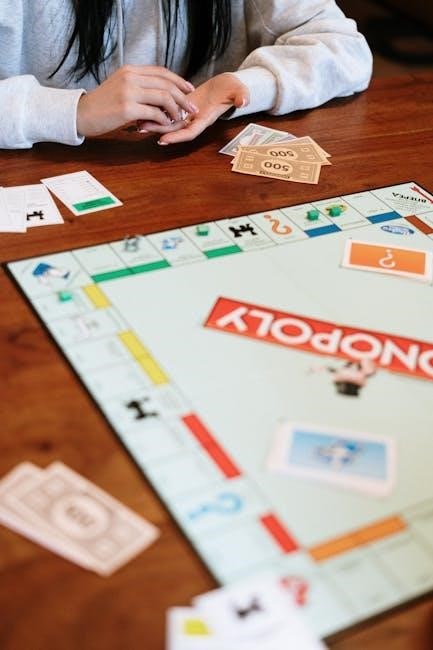Table Shuffleboard Rules: A Comprehensive Guide
Welcome to the definitive guide on table shuffleboard rules! This comprehensive resource will provide you with all the necessary information to understand and play this engaging game. From basic gameplay to scoring intricacies‚ we cover it all. Whether you’re a beginner or seasoned player‚ understanding the rules ensures fair play and enjoyment.
Table shuffleboard‚ a captivating game of precision and strategy‚ has been enjoyed for centuries. Originating from floor shuffleboard‚ its tabletop adaptation brings the excitement into homes and recreational spaces. This game involves players skillfully sliding weighted pucks‚ often referred to as weights‚ down a long‚ smooth table toward scoring zones at the opposite end.
The allure of table shuffleboard lies in its blend of skill and chance. Players must master the art of applying the right amount of force and angle to strategically position their pucks while simultaneously attempting to knock opponents’ pucks off the table or into less advantageous scoring positions.
This guide aims to provide a comprehensive understanding of the rules governing table shuffleboard. Whether you’re a novice eager to learn the basics or an experienced player seeking to refine your technique‚ this resource will serve as your go-to reference for mastering the nuances of this classic game. Prepare to embark on a journey into the world of table shuffleboard‚ where skill‚ strategy‚ and a bit of luck converge to create an engaging and rewarding experience.

Objective of the Game
The primary objective in table shuffleboard is deceptively simple: accumulate the highest score by strategically positioning your weighted pucks within the designated scoring zones at the far end of the table. Players achieve this by skillfully sliding their pucks‚ aiming for the highest-value zones while simultaneously disrupting their opponent’s attempts to score.
However‚ the path to victory is far from straightforward. Players must carefully consider the existing arrangement of pucks on the table‚ anticipating the potential consequences of each shot. A well-placed puck can not only secure valuable points but also knock opposing pucks out of scoring position‚ turning the tide of the game.
The game continues until one player or team reaches a predetermined score‚ typically 15‚ 21‚ or even 75 points‚ depending on the specific rules being followed. Achieving this target requires a combination of precision‚ tactical thinking‚ and a bit of luck‚ making table shuffleboard a captivating and challenging game for players of all skill levels. Master the art of strategic puck placement and you’ll be well on your way to dominating the shuffleboard table.
Equipment Needed for Table Shuffleboard
To properly engage in a game of table shuffleboard‚ you’ll need a few essential pieces of equipment. The most obvious‚ and arguably most important‚ is the shuffleboard table itself. These tables come in varying lengths‚ typically ranging from 12 to 22 feet‚ and feature a smooth‚ often lacquered‚ surface that allows the pucks to glide effortlessly.
Next‚ you’ll require the pucks‚ also known as weights. These are typically made of metal and have a slightly concave shape to aid in their movement. A standard set includes eight pucks‚ usually divided into two distinct colors to differentiate between players or teams.
While not strictly essential‚ shuffleboard wax or powder is highly recommended. This substance is sprinkled on the table’s surface to reduce friction and ensure smooth‚ consistent puck movement. The amount of wax used can significantly impact gameplay‚ so finding the right balance is key.
Finally‚ a scoring device‚ whether it be a traditional abacus-style counter or a more modern digital display‚ will help keep track of the points throughout the game. With these items in hand‚ you’ll be well-equipped to enjoy a thrilling game of table shuffleboard.
The Shuffleboard Table
The shuffleboard table is the heart of the game‚ dictating the playing field and strategic possibilities. Typically constructed from wood‚ often maple or birch‚ the table’s surface is meticulously crafted to ensure smoothness and consistency. A glossy finish‚ usually achieved through multiple layers of lacquer or varnish‚ reduces friction and allows the pucks to glide with minimal resistance.
Regulation tables vary in length‚ commonly ranging from 12 to 22 feet‚ and have a width of approximately 20 inches. The table is divided into scoring zones at each end‚ marked by lines that designate different point values. These zones are crucial for strategic play‚ as players aim to land their pucks in the highest-scoring areas.
A “foul line” is present at each end of the table‚ dictating the minimum distance a puck must travel to be considered in play. The table’s construction and dimensions significantly influence gameplay‚ requiring players to adjust their strategies based on the table’s specific characteristics.
Maintaining the table’s surface is vital for optimal performance. Regular cleaning and the application of shuffleboard wax are necessary to ensure a smooth‚ consistent playing experience.
Pucks (Weights)
The pucks‚ also known as weights‚ are essential components of table shuffleboard‚ each player or team having a set of four. These pucks are typically made of metal‚ often steel‚ and are slightly weighted to provide momentum and stability as they slide across the table surface. The standard diameter of a puck is around 2 1/8 inches‚ and they usually weigh between 9 and 12 ounces‚ ensuring they can traverse the length of the table with controlled force.
Pucks are differentiated by color‚ usually red and blue‚ allowing players to easily identify their own during gameplay. The color distinction is crucial for scoring and strategic play‚ helping players track their progress and plan their next moves. High-quality pucks are designed for consistent performance‚ with a smooth‚ polished surface that minimizes friction and ensures a predictable trajectory.
Players must handle the pucks with care‚ as damage can affect their performance. Scratches or dents can alter their trajectory‚ leading to unpredictable shots. Proper storage and cleaning are essential to maintain their quality and ensure fair play. The pucks are not just tools but integral parts of the game that require respect and attention.
Basic Gameplay
The core of table shuffleboard revolves around players alternating shots‚ aiming to strategically position their pucks within the scoring zones at the opposite end of the table. Players stand at the same end‚ taking turns sliding their pucks towards the target area. The objective is to outscore the opponent by landing pucks in higher-value zones or strategically knocking off opposing pucks.
Each player has four uniquely marked pucks. Players shoot from the far end until all eight pucks have been shuffled. A key element of the gameplay is the alternating shot sequence. This ensures fairness and requires players to adapt their strategy based on the opponent’s previous shot. This back-and-forth dynamic adds a layer of complexity and excitement to each round.
Understanding the basic gameplay is crucial for both beginners and seasoned players. The alternating shots‚ strategic puck placement‚ and the ability to knock off opponents’ pucks combine to create a dynamic and engaging game. Whether playing casually or competitively‚ mastering these fundamentals is essential for success and enjoyment of table shuffleboard.

Starting the Game

The commencement of a table shuffleboard game involves a simple yet important process. Typically‚ a coin flip determines which player or team gets the initial advantage. The winner of the coin toss has the privilege of choosing the color of the pucks they will use throughout the game‚ as well as the option to go first or defer to their opponent.

This initial choice can be strategic‚ as some players may have a preference for a particular puck color or feel more confident going first or second. Once the starting player is determined‚ they will step up to the designated shooting area at one end of the table.
The opposing player or team will then take their position at the same end of the table‚ ready to alternate shots. With the starting player in position‚ the game is officially underway. This simple beginning sets the stage for a strategic and engaging match of table shuffleboard‚ where skill and calculated moves determine the ultimate victor.
Alternating Shots
Once the game has commenced‚ the gameplay proceeds with players alternating their shots. Players or teams will take turns sliding their pucks down the table towards the scoring area at the opposite end. Only one player shoots at a time. This alternation ensures fairness and allows each side to strategically position their pucks and attempt to knock off their opponent’s pieces.
The order of play remains consistent‚ with each player or team taking their turn after the previous shot has concluded. This continues until all pucks have been played by both sides‚ typically four pucks per player in a standard game. Maintaining this alternating pattern is crucial for the integrity of the game‚ as it prevents one side from dominating the scoring area without giving the other a chance to respond.
Strategic thinking and precise execution are key during this phase‚ as each shot can significantly impact the overall outcome of the game. The alternating shot sequence is a fundamental aspect of table shuffleboard that promotes balanced competition and strategic gameplay.
Shooting Technique
Developing a consistent shooting technique is paramount for success in table shuffleboard. The fundamental approach involves holding the puck comfortably and using a smooth‚ controlled motion to propel it down the table. Aiming is crucial; players must carefully align their shot to achieve the desired trajectory and placement. This involves visualizing the path of the puck and accounting for any potential obstacles or strategic advantages.

The release of the puck should be fluid and consistent‚ avoiding jerky movements that can disrupt accuracy. Many players develop a preferred stance‚ often involving a slight bend at the knees and a steady arm. Mastering the appropriate amount of force is also essential. Too little force and the puck may not reach the scoring area; too much and it could overshoot or knock off other pucks unintentionally. Practice and repetition are key to refining one’s shooting technique.
Experimenting with different grips and release points can help players discover what works best for them. Ultimately‚ a solid shooting technique enables players to consistently place their pucks strategically‚ maximizing their scoring potential and gaining a competitive edge.
Scoring Rules
Understanding the scoring rules is essential for playing table shuffleboard effectively. Points are awarded based on where the pucks land within the designated scoring zones at the far end of the table. Typically‚ the zones are marked with different point values‚ with the highest value usually closest to the end of the table. A puck must completely cross the scoring line to count for that value; if it’s touching the line‚ the lower value applies.
Only pucks that remain entirely on the table within the scoring zones are eligible for points. Any puck that falls off the end of the table‚ or crosses the side lines‚ is considered out of play and scores no points. Additionally‚ a puck must pass the near foul line to be eligible for scoring.
At the end of each round‚ also known as an “end‚” the points are tallied. Only one player or team can score per round. If both teams have pucks in the scoring zones‚ only the puck or pucks furthest down the table count. All pucks closer to the players are removed. The player or team with the highest score wins the round‚ and those points are added to their cumulative score. The game continues until one player or team reaches a predetermined score‚ typically 15‚ 21‚ or 50.
Scoring Zones
The scoring zones are critical areas at each end of the shuffleboard table‚ dictating how points are awarded. These zones are typically marked with lines and numerical values‚ indicating the points a puck earns when it comes to rest within that zone. The layout and point values can vary slightly depending on the table and specific rules being used‚ but the general concept remains consistent.
Commonly‚ the scoring zones are divided into three or four sections. The zone furthest from the players‚ closest to the end of the table‚ usually carries the highest point value‚ often worth three points. The middle zones are typically worth two points‚ and the zone closest to the center of the table is worth one point. Some tables may also include a special area‚ such as a “10-off” zone‚ which can deduct points if a puck lands there.
For a puck to score‚ it must entirely cross the line separating the zones without touching it. If a puck is touching a line‚ it is scored as being in the lower-value zone. Pucks that hang over the edge of the table without falling are often considered to be in the highest scoring zone. Understanding these nuances is key to maximizing your score and strategically playing the game.
Knocking Off Opponent’s Pucks
A significant strategic element in table shuffleboard is the ability to knock off your opponent’s pucks. This involves deliberately shooting your puck to collide with an opponent’s puck‚ ideally removing it from a scoring position or knocking it off the table entirely. Mastering this skill can significantly impact the game’s outcome‚ turning a potential loss into a victory.
Knocking off opponent’s pucks serves several purposes. First‚ it eliminates the opponent’s potential points. Second‚ it can clear the scoring zones‚ creating space for your own pucks. Third‚ a well-executed knock-off can even position your own puck for a higher score. This tactic requires precision and an understanding of angles and force.
However‚ there are risks involved. A poorly aimed shot could result in your puck also being knocked off the table or into a less advantageous position. It’s crucial to assess the situation carefully before attempting a knock-off. Consider the positions of all pucks‚ the angles involved‚ and the potential consequences of your shot. A calculated risk can pay off handsomely‚ but a reckless one could cost you the game. The ability to strategically knock off opponent’s pucks is what separates a good player from a great one.
Foul Lines and Penalties
Understanding the foul lines is crucial in table shuffleboard‚ as they determine the validity of a shot. A foul line‚ often referred to as the “short foul line” or “long foul line” depending on the tournament rules‚ dictates the minimum distance a puck must travel to be considered a legal shot. Failure to cross this line results in a foul‚ and the puck is immediately removed from play‚ yielding no points for that shot.

The specific placement of the foul line can vary‚ impacting gameplay strategy. If a puck fails to completely cross the specified foul line‚ it’s deemed a foul. This means even if a portion of the puck is touching the line‚ it’s still considered a foul. This rule is strictly enforced to ensure fairness and prevent players from gaining an unfair advantage by barely nudging the puck forward.
Penalties for violating the foul line rule are straightforward: the shot is nullified‚ and the puck is removed. There are no warnings or second chances. Awareness of the foul line’s location and careful execution of each shot are essential to avoid unnecessary penalties. Mastering the right amount of force and precision guarantees adherence to the rules.
Short Foul Line vs. Long Foul Line
In table shuffleboard‚ a key variation lies in the use of either a short or long foul line‚ each influencing gameplay significantly. The short foul line‚ common in major tournaments‚ demands greater precision‚ requiring players to impart more force to propel the puck past it. Conversely‚ the long foul line offers a more forgiving threshold‚ enabling players to use less power.
The choice between short and long foul lines alters strategy profoundly. With a short foul line‚ mastering the shooting technique becomes paramount‚ demanding a delicate balance of power and accuracy. Players must avoid overshooting or undershooting‚ both resulting in penalties. The long foul line‚ however‚ allows for a broader margin of error‚ encouraging strategic nudges and tactical placements.
Tournament directors typically designate which foul line is in play before the game commences. Understanding this distinction is vital for adapting one’s approach. Short foul lines often lead to more deliberate‚ controlled shots‚ while long foul lines may encourage riskier maneuvers. Adaptability to either type of foul line is a hallmark of a skilled table shuffleboard player‚ showcasing their mastery of the game’s nuances.
Table Etiquette

Table etiquette is paramount in table shuffleboard‚ ensuring a fair and enjoyable experience for all participants. Respect for opponents and the game itself is fundamental. Players should maintain a courteous demeanor‚ avoiding disruptive behaviors that can detract from the competition’s integrity; This includes refraining from excessive noise or unsportsmanlike conduct.
A key aspect of table etiquette involves respecting the opponent’s turn. Players should remain still and silent while their opponent is shooting‚ avoiding any distractions that could impede their focus. Furthermore‚ it is considered impolite to offer unsolicited advice or criticism to an opponent during gameplay.
Another essential element of table etiquette is respecting the equipment. Players should handle the pucks and the table with care‚ avoiding any actions that could damage them. Hitting or shaking the table is strictly prohibited‚ as it can disrupt the game and compromise its fairness. Adhering to these guidelines fosters a positive and respectful environment‚ enhancing the overall table shuffleboard experience.
Prohibited Actions

In table shuffleboard‚ certain actions are strictly prohibited to maintain fair play and ensure the integrity of the game. Tampering with the table surface‚ such as applying foreign substances to alter the puck’s trajectory‚ is forbidden. Intentionally disrupting an opponent’s shot‚ whether through physical interference or disruptive behavior‚ is also prohibited and considered unsportsmanlike conduct.
Furthermore‚ players must not cross the foul line during their shot. Doing so results in a foul‚ and the shot is invalidated. Altering the pucks in any way‚ such as by adding weight or modifying their surface‚ is strictly prohibited. Any attempt to gain an unfair advantage through these means will result in penalties and potential disqualification.
Players are also prohibited from distracting or obstructing their opponent’s view of the table or the target area. Maintaining a respectful distance and avoiding unnecessary movements during an opponent’s shot are essential. Adherence to these prohibitions ensures a level playing field and promotes a positive and sportsmanlike atmosphere for all participants involved in table shuffleboard.
Variations of Table Shuffleboard
Table shuffleboard offers several exciting variations that add unique twists to the standard gameplay. One popular variation involves altering the scoring zones‚ assigning different point values to specific areas on the board. This variation can introduce strategic elements‚ as players must carefully consider their shots to maximize their score based on the modified zone values.

Another variation focuses on handicapping‚ where players with varying skill levels are given adjustments to even the playing field. This can involve awarding extra points to less experienced players or adjusting the distance they must shoot from. This ensures that everyone can participate and enjoy the game‚ regardless of their skill level.
Some variations incorporate obstacles or targets on the table‚ requiring players to navigate around or aim for specific targets to earn bonus points. These obstacles can range from simple blocks to more complex arrangements‚ adding a layer of challenge and creativity to the game. By introducing these variations‚ players can explore new strategies and keep the game fresh and engaging.
Knock-Off
Knock-Off is a thrilling variation of table shuffleboard‚ governed by specific rules that intensify the competition. In this version‚ the primary objective is to strategically eliminate your opponent’s pucks from the scoring zone while simultaneously positioning your own for maximum points. This adds a layer of tactical depth‚ requiring players to think defensively and offensively with each shot.
The game begins with players alternating shots‚ aiming to either knock off opponent’s pucks or land their own in high-scoring areas. A successful knock-off not only removes a threat but can also open up opportunities for scoring. Strategic positioning is crucial‚ as players must anticipate their opponent’s moves and protect their own pucks from being targeted.
Fouls in Knock-Off can result in penalties‚ such as the removal of one of the player’s pucks. This adds pressure to each shot‚ as accuracy and control are paramount. The game continues until one player or team reaches a predetermined score or eliminates all of their opponent’s pucks‚ declaring them the victor.
Team Play
Team play in table shuffleboard elevates the game to a collaborative and strategic experience. Typically involving two teams of two players each‚ this variation fosters communication and coordination between teammates. Team members position themselves at opposite ends of the table‚ maintaining their positions throughout the duration of the game. This setup necessitates a shared understanding of strategy and shot placement.
The alternating shots now involve teammates working in tandem to either score points or strategically disrupt the opposing team’s pucks. Communication between teammates becomes vital for planning offensive and defensive maneuvers. Coordinating shots to set up scoring opportunities or protect existing puck placements is key to success.
Scoring in team play follows similar principles as individual play‚ but the cumulative score of both teammates determines the overall team score. This encourages players to support each other‚ covering weaknesses and capitalizing on strengths. Team play highlights the social aspect of table shuffleboard‚ emphasizing teamwork and shared victory or defeat.